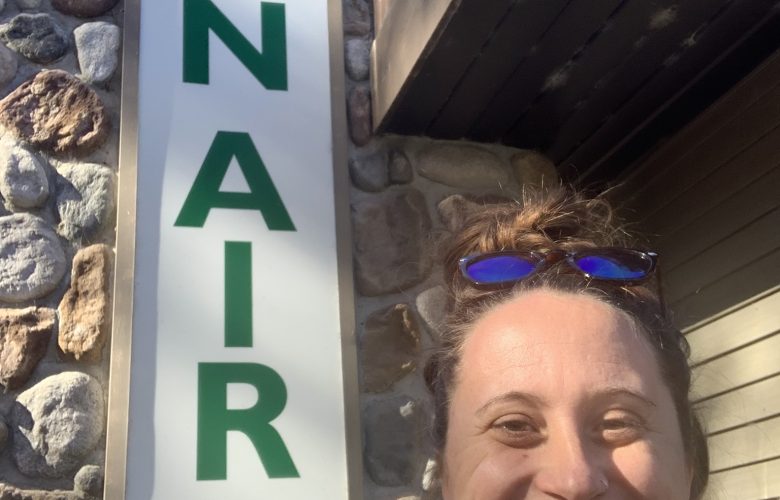Excerpt from a new local novel
By Jim Olson
Current Contributor
“The Opinion of Judge Odom Holmes”
The headline read, “Protesters Jailed for Trespass, Obstruction of Justice.” The story read:
City-on-the-Bay, Michigan. MYTHON, one of the world’s largest natural resource mining corporations, has announced that it has acquired lease rights and permits to the Voyager Point Sand Dune, and that it will start mining the sand for its industrial processes in two weeks. The Natural Resources Commission approved the permit last week in an emergency session over the cries of busloads of protesters. Environmental groups threatened to file suits to protect the mound and the dune. They claim it is unique to the world with rare vegetation, contours, and is valuable for recreation and scientific study. Groups calling themselves People of the Dune and the Mound People Coalition have set up an encampment of tents near the base of Voyager Point Dune.
The next day, people from everywhere, protesting the plight of the “Voyager Dune Seven,” showed up at the foot of the dune. So many people had set up tents, they set up a sign, dubbing the camp “Dune Village.” Its population ballooned to over 2,000, with food trucks, water tankers, porta-johns, and beer tents. The technicians from a summer music festival called Bliss showed up and set up a stage and sound system. Protesters surrounded Mython’s corporate prefabricated office and maintenance garage to the pounding beat of a bodhran from an Irish folk band. Fifty armed Pinkerton guards cordoned off the entrance road.
“Let’s hear it for the sacred mound and Voyager Dune!” cheered a translucent-eyed coed.
“Better than Woodstock,” quipped a middle-aged, bald, bearded man in a T-shirt with a hand-painted yellow dune on the front.
A week later, after the corporation announced it would begin mining, the People of the Dune and Mound People Coalition, representing the tribes, and a man named Solon Creek filed lawsuits to stop the mining of the dune and protect the supposed, mysterious sacred mound. Soon after, the Bay Ecology Council sought to intervene to protect the dune’s habitat and the creek. Another organization, the International Society to Preserve Indigenous Lands, also sought intervention because local tribal people had become members.
The Social Justice Committee for People of Color joined the group. The International Rights of Nature Coalition joined, claiming the dune has the rights of a person. A Society for the Esoteric Study of Last Things jointly sought to intervene, claiming the mining would destroy their ability to learn what the mounds and dunes mean for the future of humankind. There was even a group calling itself the Society of International Doctors of Ology, whose members offered opinions and integrative studies on everything.
Mython World Mining Corporation denied the claims, spouting that the lawsuits were “spurious” and other legal jargon. Corporate officials showered brochures on the community, assuring everyone that the public welfare of the state required the mining.
The Hearing
The court hearing began two weeks after the newspaper article reported the date that the mining of the dune would begin. Three days before the hearing, the organizations that brought the lawsuit met to map out a strategy if they would lose. After several hours of disagreement over civil disobedience and justified criminal disruption, they decided to defy any court action that allowed the company to mine.
As the hearing began, trial judge Odom Holmes came out of his office chambers behind the court’s bench, carrying a book in one hand and a hammered-bronze, table-sized sculpture of Lady Justice with scales, sword, and blindfold in the other, which he placed next to him on the top of the bench. The court clerk placed a stack of files and documents on his deck high enough to hide behind. Judge Holmes winced when he looked beyond the oak railing, where a retinue of 23 lawyers, experts, and assistants sat crowded around two long counselor tables. A crowd packed the courtroom, spilling into the corridor. The July heat was sweltering. Foreheads and pipes sweated. Air conditioning vents roared.
When Judge Holmes opened the top file from the stack next to him, he saw the two pages of lawyers and law firms who had filed papers in the case. If I can figure out which lawyer goes with which client or party; I’ll be on my way to finishing in two months, he thought. This was not something he relished doing during the sweet-spot days of summer. Luckily, his clerk began placing lawyer-client name tags on the front of the suitcoat of each lawyer.
A woman wearing dark pants, silk blouse, and blazer—one of a long line of corporate lawyers sitting at tables on the defense side—stood up waving a certified copy of defendant’s Exhibit 1, the company’s warranty deed, “All this evidence is completely subjective and immaterial to my client’s undisputed ownership rights. This case is not about good and evil, it’s about my client’s deed, title, and exclusive rights to do whatever it wants to do with its land.”
Judge Odom Holmes began ruminating. The mining company’s private property for its own use and profit? The many people represented by the plaintiffs for their leisure and enjoyment. No one? Who? A relationship between people and nature. Didn’t that count for something? The loss of the mound a potential cultural genocide? The gap in the dune an identity crisis, a gap or blind spot in human nature or the mind? Judge Holmes unknowingly put his hand on Lady Justice’s blindfold and gazed back at the long train of lawyers.
The tribe’s lawyer, Rastellar, stood up and spoke. “Your honor, it’s our position… well, to the point. The mound or dune, itself, existed long before this idea of property came along. And my clients’ relationship with the mound and the dune preexists the Treaty of 1836 that ceded ownership of the land. The truth is, nowhere in the treaty did they cede their cultural relationship to the land, the water, the plants, and the animals. Their right to fish, hunt, and gather is strong evidence of the tribal relationship to the land. Thus, any right to continue their relationship to the mound and dune is theirs, a right in the tribe, not the individual, which existed long before any federal government patent conveyed title of surveyed boundaries and property to the first property settlers in this region. Therefore, your honor, these rights could not and were not conveyed by any of the subsequent deeds, including Defendant’s Exhibit 1.”
Loud applause broke out in the courtroom.
“Nada … Nada,” the company’s lawyer retorted. “There are no court decisions in Western civilization—the United States, let alone this state—your honor, which support Mr. Rastellar’s argument.”
A Nightmare
All that night, like vultures circling their prey, Mython’s minions mobilized for a feeding frenzy. Trucks towed construction trailers, and machinery rumbled into the entrance road that pointed to the shadowed belly of the dune. Soon after, a caravan of more trucks, dump trucks, cars, and workers invaded the staging area, followed by a double-wide flatbed, an 18-wheeler semi with the massive shovel, diesel engines, twin generators, and two more trucks. The stage was set for the final act: portable pole barns, tanks for fuel, machine shop, waste pits, pump-and-haul stations, and parking areas. They moved in front-end loaders, dozers, graders, and other equipment, converted shipping-container toilets, then the beams, and the gauged track conveyor system to transport the sand from the giant shovel, ready to bite the center of the dune. The calamitous noise filled the night; the pounding of wheels and of heavy equipment shook the ground, causing the tents to wobble. Sleepless campers jumped up and put on hiking boots and shoes, dark pants and shirts, and headlamps.
Judge Holmes kicked at the bed sheets and snapped up, into a sitting position. His wife, Harriet, reached for him as he slid out of bed.
“Odie, what is it?”
“I can’t sleep,” he said. “I’m going to my office.”
He couldn’t remember what he had yelled as he awoke, but he had dreamed something, felt a shiver through his limbs. The nightmare came back to him. He stumbled through a dark forest toward an opening with milky white light. He could see it was a meadow covered in a luminous fog. When he stepped into the clearing, the fog enveloped him. He saw the dim figure of a man. A voice called to him: “Stop. Come. You must see the mound.” The fog thickened, blanketed him, lifted him off the ground. He rose into the sky … drifted over a vast sea … drifted farther, he could see sand, a dune. A whirlwind blew the sand off the ridge … there below him, he saw the shape of an animal … a panther. Then the blanket of fog dissipated, nothing, a void, and he felt as if he were falling through time until … He was standing in the meadow. A woman draped in flowing robes floated toward him … in one hand she held scales with something red … a beating heart tottering on the scales … in the other, she held a sword. A blindfold hung down from her eyes … sorrowful eyes … weeping eyes. He heard her saying something … “Take off my blindfold. Clean the rust from my sword. Protect my heart …”
—————–
Jim Olson, a trailblazer in environmental law, has written his first novel, People of the Dune, a parable of Earth and community (Mission Point Press). A book-release party—complete with reading, discussion, book purchases and signing, music, dessert, snacks, and open bar—will take place on Wednesday, June 26, from 7 to 9 p.m. at the Alluvion in the Commongrounds Cooperative building at 414 E. Eighth Street in Traverse City. Books will be available for purchase locally at The Bookstore of Frankfort after this date.
Olson is an attorney with much court experience going up against corporations, as portrayed in this excerpt from his new novel. He is also the founder and senior legal advisor for FLOW – For Love of Water, a nonprofit dedicated to protecting and preserving the natural resource and applying “public trust” principles to educate, advance policy, and provide solutions to the pressing water, energy, and climate issues facing our region, nation, and planet.
Featured Photo Caption: Jim Olson, a local legend in his own right as a trailblazer in environmental law, has written his first novel, People of the Dune, a parable of Earth and community. Image courtesy of Jim Olson/Mission Point Press.




